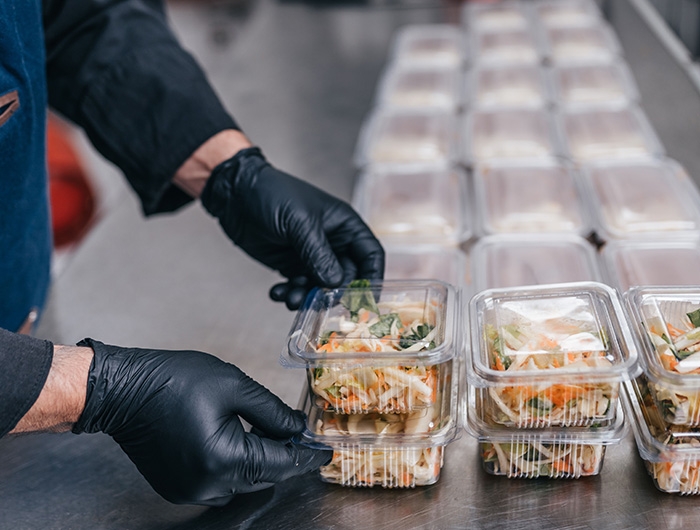Most foods contain toxic phthalates. Now what?

hedgehog94 - stock.adobe.com.
A Consumer Reports study found phthalates, a class of toxic chemicals used in plastic, present in almost all foods sampled. Phthalates are hormone disruptors linked to health concerns such as reproductive problems, birth defects, and cancer. Here’s what you should know about the hazardous chemicals and how you can reduce your exposure.
New study suggests phthalates are widely present in US processed food supply
A Consumer Reports study from January 2024 tested 85 brand-name food products, analyzing two to three samples of each food. The researchers detected phthalates in every food tested except for one: Polar Seltzer Raspberry Lime. The study tested a wide range of foods, including beverages, canned beans, condiments, dairy, fast food, grains, infant food, meat and poultry, packaged fruits and vegetables, prepared meals, and seafood.
The study found that the levels of phthalates in foods vary widely, even among a particular type of food or brand. For instance, Little Caesars pizza had approximately twice the level of phthalates as Pizza Hut pizza. Even products not stored in plastic packaging, like canned foods, still contained phthalates. And you can’t assume that buying organic will be your saving grace. Annie’s Organic cheesy ravioli had some of the highest levels of phthalates of all the foods Consumer Reports tested.
Consumer Reports also assessed the presence of BPA, another dangerous plastic additive that is part of a family of chemicals known as bisphenols. The report found much lower amounts of BPA in the foods than when Consumer Reports last tested food products in 2009. However, 79 percent of samples still contained BPA. It’s clear that these concerning chemicals are widespread in our food supply.
How phthalates end up in our food
Phthalates (pronounced “THAL-ates”) are a family of chemicals used in plastic materials as plasticizers, meaning that they help make plastics more flexible. The FDA authorizes the use of nine phthalates in a variety of food packaging and processing materials. From there, phthalates leach into the foods and beverages we eat and drink. As a result, certain phthalates can be found in most foods, making them nearly impossible to avoid.
Plastic additives can seep into our food from a variety of sources. Sometimes, phthalates enter food directly from packaging. Other times it is because phthalates are used in food processing equipment such as gloves and factory conveyor belts. Additionally, phthalates could end up in food through water or soil that is contaminated with the chemicals, according to Consumer Reports.
In addition to food and drink packaging, phthalates can be found in personal care products, pharmaceuticals, cleaning products, building materials, and other consumer products. In cosmetics, phthalates are sometimes used in nail polish, hairspray, and fragrances. But companies aren’t required to disclose all the ingredients in their fragrances, so phthalates may not show up on the label if they are used to make the fragrance. Cumulative exposure to multiple phthalates from numerous sources increases our risk of health harms.
Why are phthalates hazardous for health?
Studies indicate that some phthalates are hormone disruptors. “Disrupt” means that a chemical can turn on, turn off, or change the signals sent by hormones like estrogens, testosterone, thyroid hormones, and insulin. Accordingly, phthalates are linked to health harms including reproductive issues, miscarriage, breast cancer, and diabetes.
“The continued use of phthalates in food processing and packaging represents an ongoing public health threat with serious implications for babies, young children, and women in particular,” said Dr. Peter G. Lurie, president and executive director of CSPI. “The risk of harm outweighs whatever advantages phthalates offer to the food industry.
How regulators could address phthalates exposure
Despite decades of scientific studies linking phthalates to serious and irreversible health harms, the FDA has continued to allow the use of phthalates in food packaging and processing materials—including phthalates that were banned from use in children’s products years ago because they are not safe.
In 2016, CSPI, along with a coalition of health and environmental advocates, filed two petitions urging the FDA to ban phthalates from use in food packaging and processing equipment. Despite a legal mandate to make a final decision on the principal petition within 180 days, the FDA sat on the petition for six years. Advocates sued the FDA in federal court in December 2021, forcing the agency to finally make a decision. In May 2022, the FDA denied CSPI’s petitions.
In 2022, the FDA granted an industry petition to revoke federal approval for multiple phthalates added to food packaging and processing equipment, based on industry assertions that those uses have been abandoned. But the FDA has left multiple phthalates—including ones with the most well-developed body of scientific evidence demonstrating their toxic effects, like DEHP—on the market.
Federal law prohibits the use of chemicals in food or food-contact materials unless the scientific evidence demonstrates they are safe. Despite the clear evidence of harm caused by phthalates, the FDA has refused to revoke their authorization. CSPI will continue to call on the FDA to prohibit phthalates in food packaging and equipment to better protect consumers.
How you can reduce your exposure to plastic additives
Avoiding phthalates entirely is not possible given how widespread the chemicals are in the US food supply, cosmetics, vinyl flooring, and more. However, there are various actions you can take to help address phthalates exposure:
- You can reduce your use of plastics in your home, such as by using reusable containers as much as possible. This has a slew of additional benefits: cutting down on plastic waste, reducing microplastics pollution, and minimizing your exposure to other plastic additives such as BPA.
- You can also minimize your exposure to non-food sources of phthalates by seeking out cosmetics that are free from phthalates.
- You could also write to the FDA or your representatives in Congress to call for restrictions on the use of phthalates in food packaging and equipment. Ultimately, addressing the root causes that have allowed phthalates to linger in our food system so long will need to involve reform of the entire federal food chemical regulatory system.

Subscribe to Nutrition Action
We name names, remain strictly objective, and deliver scrupulously researched advice about food of all kinds, staying healthy with diet and exercise, and more.

